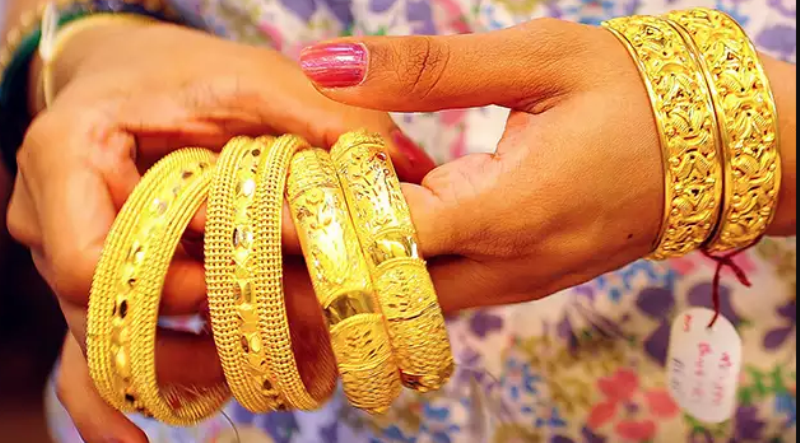KATHMANDU: The price of gold in Nepal has been surging relentlessly, reaching new highs every day.
Over the past five years, the market value of gold has doubled, with significant increases witnessed in recent months.
In April 2018, the price of gold stood at 58,000 rupees per tola, soaring to a staggering 1 lakh 36 thousand 800 rupees by April 2024, marking a substantial increase of 78,000 rupees over five years.
The trajectory of gold prices in recent years has been remarkable.
From 59,500 rupees per tola in 2019, it surged to 91,000 rupees per tola in 2020.
Although there was a slight decline in 2021, prices rebounded in 2022 BS and 2023, reaching 111,800 rupees per tola by May 4, 2023.
Despite a minor dip observed recently, experts predict a further upward trend in gold prices in the near future.
Factors contributing to this surge include the government’s decision to reduce the daily gold import quota from 20 kg to 10 kg in 2021 due to pressure on foreign exchange reserves.
However, Nepal Rastra Bank has now reinstated the previous quota of 20 kg per day.
Gold imports, totaling 1,500 kilograms worth 12.5 billion rupees between July and January, have been subject to hefty customs duties, around 12 lakhs per kilogram.
Despite this, gold importation has decreased by 60 percent compared to the previous year.
Business analysts attribute the continuous rise in gold prices to various factors, including the impact of the COVID-19 pandemic, which struck in 2019, and geopolitical tensions such as the conflict between Russia and Ukraine.
These events have heightened uncertainty in global markets, driving investors towards the traditional safe haven of gold, thereby fueling its price surge.
In the Nepali year of 2022, the price of gold saw a significant increase of 8,300 rupees per tola.
By May 4, 2023, the price of gold had risen by an additional 13,200 rupees per tola, reaching a total of 111,800 rupees per tola.
As of April 14, 2024, the price of gold slightly declined compared to the previous day, settling at 1 lakh 36 thousand 800 rupees per tola.
Local business leaders predict that gold prices will continue to rise in the near future, as they have over the past several years.
In the last seven months, 1,500 kilograms of gold, valued at 12.5 billion rupees, was imported.
Gold importers must pay approximately 12 lakh rupees in customs duty per kilogram.
Nepal Rastra Bank’s data up to the end of December last year indicates that gold imports have decreased by 60 percent compared to the same period last year.
Gold’s enduring appeal as a preferred investment and ornamental asset is one reason for its steady price increase.
Business leaders attribute the sustained rise in gold prices to the onset of the COVID-19 pandemic and the Russia-Ukraine conflict.
Since then, the price of gold has experienced consistent growth.
Additionally, international news reports suggest that China’s burgeoning demand for gold is contributing to the upward pressure on gold prices globally.
The price of gold appears to be closely tied to the value of the US dollar.
International analysts suggest that gold prices are rising due to the weakening of the US dollar on a global scale.
Central banks place high importance on gold as a long-term store of value and as a safe haven during economic and international turmoil.
Experts also link the rise in gold prices to the ongoing conflict between Israel and Hamas.
Research indicates that recent conflicts and uncertainty in various parts of the world may drive gold prices higher.
Additionally, analysts note that a potential victory for Donald Trump in the US presidential election could also lead to further increases in gold prices.
According to reports, the US Federal Reserve’s policies have contributed to the steady rise in gold prices.
They predict that the announcement of short-term tax cuts for financial investors will continue to push gold prices upward.
Domestic demand decline
Business leaders report a decline in domestic demand due to high gold prices.
During the wedding season, they typically trade 30-40 kg of gold daily, but now the volume has decreased to around 15-20 kg.
Instead of buying new gold for jewelry, customers are opting to redesign existing gold jewelry.
Diyesh Ratna Shakya, vice president of the Nepal Gold and Silver Traders Federation, noted that the usual trade volume was 40-50 kg of gold, but now it’s challenging to even reach 20-25 kg.
Shakya added that business has decreased to around 60% of previous levels.
Shakya further commented that as gold prices rise, customers are bringing in old gold for redesign instead of buying new gold. Many people cannot afford gold as its price continues to climb.
Which country has the largest gold reserves?
The United States leads the world in gold reserves, holding 8,133 tons of gold.
This accounts for over 70% of the country’s foreign exchange reserves.
Germany ranks second, with gold reserves totaling 3,353 tons.
Other countries with significant gold reserves include Italy with 2,452 tons, France with 2,437 tons, and Russia with 2,333 tons.
Italy’s national bank has plans to buy more gold to balance the national balance sheet, provided there is no agreement to sell gold.
France previously sold 572 tons of gold in 2004 and another 17 tons since then.
Russia holds approximately 1,094 billion tons of gold and has been increasing its gold reserves since the start of the year.
China, the world’s second-largest economy, purchased 43.86 tons of gold in the past year alone.
The country currently holds the sixth-largest gold reserves in the world, amounting to 2,235 tons.









Comment